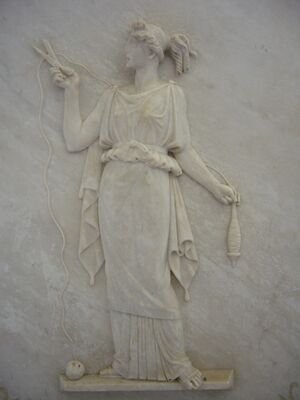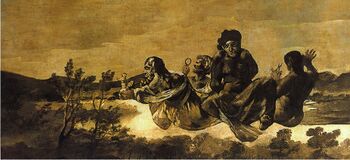أتروپوس

أتروپوس (Atropos ؛ /ˈætrəpɒs/؛ باليونانية قديمة: Ἄτροπος "بدون تقلب") أو آيسيا Aisa، في الأساطير اليونانية، كانت واحدة من ثلاث Moirai، إلهة القدر والمصير. نظيرتها الرومانية كانت مورتا.
Atropos was the oldest of the Three Fates, and was known as "the Inflexible One.[1] It was Atropos who chose the manner of death and ended the life of mortals by cutting their threads.[2] She worked along with her two sisters, Clotho, who spun the thread, and Lachesis, who measured the length. Atropos has been featured in several stories such as Atalanta[3] and Achilles.
هو واحد من ثلاثة أله للجحيم لدي اليونان والمسؤال عن قص خيط حياة البشر
الأصل
Her origin, along with the other two fates, is uncertain, although some called them the daughters of the night. It is clear, however, that at a certain period they ceased to be only concerned with death and also became those powers who decided what may happen to individuals. Although Zeus was the chief Greek god and their father, he was still subject to the decisions of the Fates, and thus the executor of destiny, rather than its source. According to Hesiod's Theogony, Atropos and her sisters (Clotho and Lachesis) were the daughters of Erebus (Darkness) and Nyx (Night) and sister to Thanatos and Hypnos, though later in the same work (ll. 901-906) they are said to have been of Zeus and Themis.
الخلاف على الأصل
In the ancient Greek poem, The Shield of Heracles, Atropos is referred to as the oldest and smallest of the three fates. This description is uncommon among references to Atropos. It is uncommon in ancient mentions of her in more ways than one as it turns out, including this fate's moniker. Its possible that Plato is behind the creation of Atropos as many of the early descriptions of the fates have Aisa as the name of this third fate, although there is still no clear consensus. The inconsistent nature of these accounts make it difficult to know for sure whether or not Aisa or Atropos is the best name to use when talking about the third fate, but evidence seems to point to Aisa being the more commonly used name earlier on, with Atropos gaining popularity later.[4]
الطب
Atropos lends her name to the genus Atropa, of which the poisonous plant Atropa belladonna (deadly nightshade) is a member, and to the alkaloid atropine, an anticholinergic drug which is derived from it.
علم الزواحف
The scientific name of a venomous snake, Bitis atropos, refers to Atropos.[5]
علم الحشرات
الفلك
الكويكب 273 أتروپوس مسمى على اسم أتروپوس.
في الفن
في الرسم
في الأدب
- رواية "انقطاع الموت" لجوزيه ساراماگو، الصفحة 2.
المراجع
- ^ Clement of Alexandria. The Exhortation to the Greeks. The Rich Man's Salvation. To the Newly Baptized. Translated by G. W. Butterworth. Loeb Classical Library 92. Cambridge, MA: Harvard University Press, 1919, pg 52-53.
- ^ Columbia Electronic Encyclopedia, 6th Edition. Columbia University Press. ISBN 9780787650155.
- ^ Baldwin, James. "The Story of Atalanta". Old Greek Stories. ISBN 978-1421932125.
- ^ Carpenter, Rhys (1925). "The Fates of the Madrid Puteal". American Journal of Archaeology. 29 (2): 117–134. doi:10.2307/497894. ISSN 0002-9114.
- ^ Beolens, Bo; Watkins, Michael; Grayson, Michael (2011). The Eponym Dictionary of Reptiles. Baltimore: Johns Hopkins University Press. xiii + 296 pp. ISBN 978-1-4214-0135-5. ("Atropos", p. 12).
وصلات خارجية
 Works related to Theogony at Wikisource
Works related to Theogony at Wikisource The Wiktionary definition of Atropos
The Wiktionary definition of Atropos وسائط متعلقة بـAtropos من مشاع المعرفة.
وسائط متعلقة بـAtropos من مشاع المعرفة.
- Short description is different from Wikidata
- Articles with hatnote templates targeting a nonexistent page
- Articles containing Ancient Greek (to 1453)-language text
- Moirai
- Greek goddesses
- Time and fate goddesses
- Children of Zeus
- Textiles in mythology and folklore
- Greek death goddesses
- Personifications in Greek mythology

